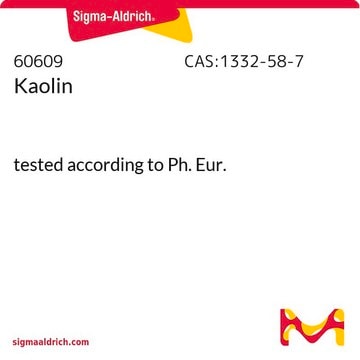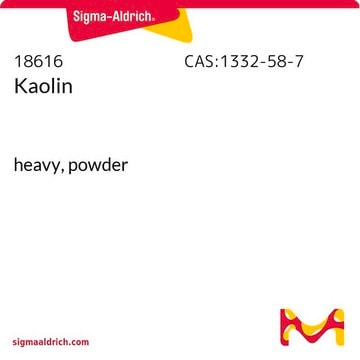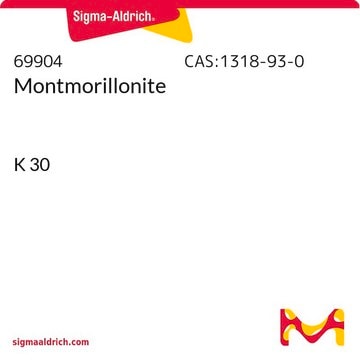If this product has an expiration or retest date, it will be shown on the Certificate of Analysis (COA, CofA). If there is no retest or expiration date listed on the product's COA, we do not have suitable stability data to determine a shelf life. For these products, the only date on the COA will be the release date; a retest, expiration, or use-by-date will not be displayed.
For all products, we recommend handling per defined conditions as printed in our product literature and website product descriptions. We recommend that products should be routinely inspected by customers to ensure they perform as expected.
For products without retest or expiration dates, our standard warranty of 1 year from the date of shipment is applicable.
For more information, please refer to the Product Dating Information document: https://www.sigmaaldrich.com/deepweb/assets/sigmaaldrich/marketing/global/documents/449/386/product-dating-information-mk.pdf
K7375
Kaolin
Sinonimo/i:
Aluminum silicate hydroxide, Bolus, Hydrated aluminum silicate
Scegli un formato
CHF 74.20
Spedizione prevista il21 maggio 2025
Scegli un formato
About This Item
CHF 74.20
Spedizione prevista il21 maggio 2025
Prodotti consigliati
Grado
for analytical purposes
Livello qualitativo
Stato
powder
Perdita
≤2.0% loss on drying
Intervallo di pH
3.5-5.0(20% in water)
pH
3.5-5.0 (20% in water)
Stringa SMILE
[Si](=O)(O[Si](=O)O[Al]=O)O[Al]=O.O.O
InChI
1S/2Al.O5Si2.2H2O.2O/c;;1-6(2)5-7(3)4;;;;/h;;;2*1H2;;/q2*+1;-2;;;;
NLYAJNPCOHFWQQ-UHFFFAOYSA-N
Cerchi prodotti simili? Visita Guida al confronto tra prodotti
Descrizione generale
Applicazioni
- For preparing synthetic turbid water that is employed to evaluate the biosorption capacity of Moringa oleifera leaves.
- In combination with carrageenan to induce arthritic inflammation in a rat model for evaluating the activity of JAK3 (janus kinase 3) inhibitors.[4]
- In a study to assess its utility for microparticle-enhanced cultivation (MPEC) of 2-phenylethanol and 6-pentyl-α-pyrone.[5]
Altre note
Note legali
Codice della classe di stoccaggio
11 - Combustible Solids
Classe di pericolosità dell'acqua (WGK)
nwg
Punto d’infiammabilità (°F)
Not applicable
Punto d’infiammabilità (°C)
Not applicable
Dispositivi di protezione individuale
Eyeshields, Gloves, type N95 (US)
Scegli una delle versioni più recenti:
Certificati d'analisi (COA)
Non trovi la versione di tuo interesse?
Se hai bisogno di una versione specifica, puoi cercare il certificato tramite il numero di lotto.
Possiedi già questo prodotto?
I documenti relativi ai prodotti acquistati recentemente sono disponibili nell’Archivio dei documenti.
I clienti hanno visto anche
-
How can I determine the shelf life / expiration / retest date of this product?
1 answer-
Helpful?
-
-
How is shipping temperature determined? And how is it related to the product storage temperature?
1 answer-
Products may be shipped at a different temperature than the recommended long-term storage temperature. If the product quality is sensitive to short-term exposure to conditions other than the recommended long-term storage, it will be shipped on wet or dry-ice. If the product quality is NOT affected by short-term exposure to conditions other than the recommended long-term storage, it will be shipped at ambient temperature. As shipping routes are configured for minimum transit times, shipping at ambient temperature helps control shipping costs for our customers. For more information, please refer to the Storage and Transport Conditions document: https://www.sigmaaldrich.com/deepweb/assets/sigmaaldrich/marketing/global/documents/316/622/storage-transport-conditions-mk.pdf
Helpful?
-
-
I need to know the particle size of this reagent. Thanks
1 answer-
The particle size range is 0.1 - 4 microns.
Helpful?
-
Active Filters
Il team dei nostri ricercatori vanta grande esperienza in tutte le aree della ricerca quali Life Science, scienza dei materiali, sintesi chimica, cromatografia, discipline analitiche, ecc..
Contatta l'Assistenza Tecnica.














